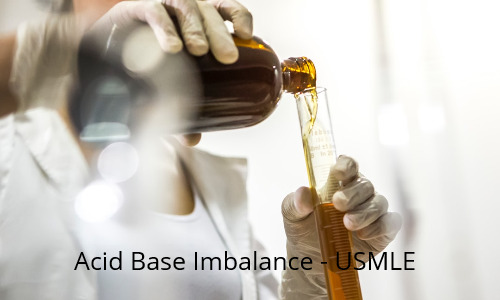Library
Case studies- Acid Base Balance and Imbalance
- November 11, 2019
- Posted by: Namrata Chhabra
- Category: Practice questions Acid-base balance and imbalance Case studies Learning resources Library

Case details-1
A 45 year-old-female suffering from bronchial asthma was brought to an emergency in a critical state with extreme difficulty in breathing.
The blood gas analysis revealed the following
pH- 7.3
PCO2- 46 mm Hg
PO2- 55 mm Hg
HCO3- 24meq/L
What is your Interpretation?
Case discussion-
Low pH – acidosis
Low PO2 and PCO2 excess signify Primary respiratory problem
HCO3:24 -normal
Thus, the patient is suffering from Acute respiratory acidosis.
Case details -2
A 4-day old girl neonate became lethargic and uninterested in breast-feeding. Physical examination revealed tachypnea (rapid breathing) with a normal heartbeat and breath sounds. Initial blood chemistry values included normal glucose, sodium, potassium, chloride, and bicarbonate (HCO3-) levels.
Blood gas values revealed a pH of 7.53, partial pressure of oxygen (PO2) was normal (103 mm Hg) but PCO2 was 27 mmHg.
What is the probable diagnosis?
Case discussion
The baby is suffering from Respiratory Alkalosis
Tachypnea in term infants may be due to brain injuries and metabolic diseases that irritate the respiratory center. The increased respiratory rate removes carbon dioxide from the lung alveoli and lowers blood CO2, forcing a shift in the indicated equilibrium towards left
CO2 + H2O çè H2CO3 çè H+ + HCO3-
Carbonic acid (H2CO3) can be ignored because negligible amounts are present at physiological pH, leaving the equilibrium
CO2 + H2O çè H+ + HCO3-
The leftward shift to replenish exhaled CO2 decreases the hydrogen ion (H+) concentration and increases the pH to produce alkalosis. This respiratory alkalosis is best treated by diminishing the respiratory rate to elevate the blood [CO2], to force the above equilibrium to the right, elevate the [H+], and decrease the pH.
Case details-3
A new-born with tachypnea and cyanosis (bluish color) is found to have a blood pH of 7.1. Serum bicarbonate is measured as 12 mM while pCO2 is 40 mm Hg.
What is the probable diagnosis?
Case discussion
Low pH and low bicarbonate indicate metabolic acidosis. Since p CO2 is normal it can not be compensatory respiratory acidosis (If the baby had respiratory acidosis, the PCO2 would have been elevated). This is a hypoxia-related metabolic acidosis. Hyperventilation is as compensation to metabolic acidosis.
This condition can be treated by the administration of oxygen to improve tissue perfusion and decrease metabolic acidosis.
Case details -4
A 60-year-old man was brought to the hospital in a very serious condition. The patient complained of constant vomiting containing several hundred mL of dark brown fluid from the previous two days plus several episodes of melaena. Past history of alcoholism, cirrhosis, portal hypertension and a previous episode of bleeding varices was there.
Arterial Blood Gases revealed-
pH – 7.10
pCO2 – 13.8 mmHg
pO2- 103 mmHg
HCO3- 14.1 mmol/l
Laboratory Investigations
Na+ 131 mmol/l., Cl– 85 mmol/l. K+ 4.2 mmol/l., “total CO2” 5.1, glucose 52mg/dl, urea 38.6mg/dl, creatinine 1.24mg/dl, lactate 20.3 mmol/l Hb 6.2 G%, and WBC- 18 x103/mm3
Case discussion
The patient is severely ill with circulatory failure and GI bleeding on a background of known cirrhosis with portal hypertension.
The very low pH indicates a severe acidosis. The combination of a low pCO2 and low bicarbonate indicates either metabolic acidosis or a compensatory respiratory alkalosis (or both). As this patient has a severe acidosis, so the most probable diagnosis is metabolic acidosis. The anion gap is 31 indicating the presence of a high anion gap disorder. The lactate level of 20.3mmol/l is extremely high and this confirms the diagnosis of severe lactic acidosis. Hb is very low consistent with the history of bleeding and hypovolemia. Urea and creatinine are elevated (renal failure) but at these levels, there would not be retention of anions sufficient to result in renal acidosis. Hence, Lactic acidosis can be suspected. The respiratory efforts may be due to the distress or as a consequence of metabolic acidosis (ie compensatory).
Case details-5
A 56- year -old man who smoked heavily for many years developed worsening cough with purulent sputum and was admitted to the hospital because of difficulty in breathing. He was drowsy and cyanosed. His arterial blood gas analysis was as follows;
pH – 7.2
p CO2 – 70 mm Hg
HCO3- 26 mmol/L
P O2- 50 mm Hg
What is the likely diagnosis?
Case discussion
The patient is suffering from Respiratory acidosis. Difficulty in breathing, cough, and purulent sputum signify the underlying lung pathology. Low pH and raised pCO2 indicate respiratory acidosis. Slightly high HCO3- may be due to compensation as a result of increased reabsorption from the kidney. The low pO2 is due to associated hypoxia. The treatment is based on treating the primary cause.O2 and mechanical ventilation are often needed.
Case details -6
A 5-year old girl displayed increased appetite, increased urinary frequency, and thirst. Her physician suspected new-onset diabetes mellitus and confirmed that she had elevated urine glucose and ketones.
Blood gas analysis revealed
pH-7.33
Bicarbonate-12.0 mmol/L
Arterial PCO2- 21
Case discussion
The patient is suffering from Diabetic ketoacidosis
In the presence of insulin deficiency, a shift to fatty acid oxidation produces the ketones that cause metabolic acidosis. The pH and bicarbonate are low, and there is frequently some respiratory compensation (hyperventilation with deep breaths) to lower the PCO2. A low pH with high PCO2 would have represented respiratory acidosis which is not there in the given case.
Case details-7
A 19-year-old boy was brought to the emergency department with the loss of consciousness. Apparently the patient was a homeless found on the street.
Arterial blood gases revealed-
pH – 7.33,
pCo2 – 28 mm Hg,
pO2- 117 mmHg and
HCO3- 14 mmol/L
The blood level of methanol was 0.4 mg/dl.
What is your diagnosis?
Case discussion
The patient is suffering from metabolic acidosis as evident from the low pH and low bicarbonate levels. Low p CO2 and high p O2 signify that the patient is in a state of respiratory compensation. Blood methanol level is high, so it might be the case of Methanol poisoning producing metabolic acidosis.
Case details-8
A 66-year-old man had a postoperative cardiac arrest. A past history of hypertension treated with an ACE inhibitor was there. There was no past history of Ischemic heart disease. Following reversal and extubation, myocardial ischemia was noticed on ECG. He was transferred to ICU for overnight monitoring. On arrival in ICU, BP was 90/50, pulse 80/min, respiratory rate was 16/min and S pO2 99%. During a handover to ICU staff, he developed ventricular fibrillation which reverted to sinus rhythm with a single 200J countershock. Soon after, blood gases were obtained from a radial arterial puncture:
Arterial Blood Gases
pH -7.27
pCO2 -55.4 mmHg
pO2- 144 mmHg
HCO3- 24.3 mmol/l
Biochemistry Results (all in mmol/l): Na+ 138, K+ 4.7, Cl– 103, urea 6.4, creatinine 0.07
What is the probable diagnosis?
Case discussion
1) pH- low, Acidosis is present.
2) p CO2- high, hypoventilation(The residual depressant effect of the Anesthetic agents is considered the most likely cause)
3) Bicarbonate– near normal
4) pO2- high- This is because the patient is breathing a high inspired oxygen concentration. If the patient had been breathing room air (FIO2 = 0.21), then depression of alveolar pO2 must have occurred. Most ill patients in hospitals breathe supplemental oxygen so it is common for the pO2 to be elevated on blood gas results.
5) An acidemia with the pattern of elevated pCO2 and normal HCO3 is consistent with an acute respiratory acidosis.
6) Anion gap– The anion gap is about 11 which is normal so no evidence of a high anion gap acidosis.
Diagnosis- Acute respiratory acidosis
Cause- Resuscitation from postoperative ventricular fibrillation
Case details -9
A 72-year-old male with diabetes mellitus is evaluated in the emergency room because of lethargy, disorientation, and long, deep breaths (Kussmaul respiration). Initial chemistries on venous blood demonstrate a high glucose level of 380 mg/dl (normal up to 120 mg/dl) and a pH of 7.3. Bicarbonate 15mM and PCO2 30 mmHg, What is the probable diagnosis?
Case discussion
The man is acidotic as defined by pH lower than normal 7.4. His hyperventilation with Kussmaul respiration can be interpreted as compensation by lungs to blow off CO2 to lower PCO2, to increase [HCO3-]/[CO2] ratio, and to raise pH. Thus the patient has metabolic acidosis due to underlying Diabetic ketoacidosis.
Case details-10
A 24 year female with a broken ankle was brought to an emergency with acute pain.
Blood gas analysis revealed the following
pH- 7.55
PCO2- 27
PO2- 105,
HCO3- 23
What is the probable diagnosis?
Case discussion
pH:- 7.55 – indicates Alkalosis
PCO2: 27 -low, it is a Primary respiratory disturbance
PCO2 Deficit = 40-27 = 13
HCO3 = 23 (Normal)
Interpretation:
It is Respiratory alkalosis due to pain-related hyperventilation.
Author:Namrata Chhabra
Leave a Reply Cancel reply
You must be logged in to post a comment.
